
Demand-Controlled Exhaust Systems:
The Intergovernmental Panel on Climate Change (IPCC) has warned that global warming must be limited to 1.5°C above pre-industrial levels in order to avoid the worst impacts of climate change, such as extreme weather events, sea-level rise, and ecosystem collapse. To achieve this, global carbon emissions need to be reduced by at least 50% by 2030 and reach net zero by 2050.
Achieving the necessary reductions in global carbon emissions will require significant changes in energy production, transportation, and land use. This will require a collective effort from governments, businesses, and individuals around the world to transition to cleaner and more sustainable practices.
Decarbonization refers to the process of reducing the amount of greenhouse gas emissions (GHG) associated with energy production, transportation, and other sectors.
As the world faces the urgent need to reduce carbon emissions, states and cities are increasingly taking action to decarbonize their economies. Many are implementing regulations and policies to reduce their carbon footprints through renewable energy, energy-efficient buildings, and sustainable transportation.
ASHRAE recently released its latest version of its benchmark energy efficiency standard, ANSI/ASHRAE/IES Standard 90.1-2022, Energy Efficiency Standard for Sites and Buildings Except Low-Rise Residential Buildings. The latest version includes an expanded scope for building sites and major additions appearing for the first time in a minimum-efficiency U.S. model energy standard or code. One significant addition in this context is the introduction of the Fan Energy Index (FEI rating) and sets an energy-efficiency requirement for exhaust fans.

ASHRAE’s positions and standards are significant on a national level as the ASHRAE 90.1 standard is the basis of many energy standards and building codes throughout the US.
● California – California has been at the forefront of climate action in the United States. The state's landmark climate legislation, the Global Warming Solutions Act of 2006 (AB 32), set a target to reduce GHG emissions to 1990 levels by 2020. In 2018, California passed Senate Bill 100 (SB 100), committing to 100% carbon-free electricity by 2045.
Additionally, California has implemented a cap-and-trade program, Low Carbon Fuel Standard (LCFS), and stringent vehicle emissions standards. Gas-fired appliances, like space and water heaters, will become unavailable for purchase by 2030.
● New York – The Climate Leadership and Community Protection Act (CLCPA) of 2019 established New York's ambitious climate goals. The act requires 70% of electricity to come from renewable sources by 2030 and mandates a carbon-free electricity system by 2040. Furthermore, the state is targeting an 85% reduction in GHG emissions below 1990 levels by 2050. Any new building constructed after 2027 must be gas hookup free.
● Los Angeles, California – The city is working toward its "LA's Green New Deal," a comprehensive sustainability plan that outlines aggressive decarbonization targets. The city aims to achieve 100% renewable energy by 2045 and a fully electric transportation system by 2050.
● New York City, New York – Local Law 97 requires any building over 25,000 feet to meet increasingly stricter emission limits by the years 2024, 2030 (40% decrease), and 2050 (80% decrease).
● Seattle, Washington – Seattle's Climate Action Plan sets ambitious goals to be carbon neutral by 2050. Starting in 2027, no gas hookups can be installed in newly constructed buildings. The city aims to reduce GHG emissions by 58% by 2030 through measures such as building energy efficiency, transportation electrification, and increasing renewable energy capacity.
● Washington D.C. – Washington D.C. is committed to achieving carbon neutrality by 2050, as outlined in its Clean Energy DC plan. The city has set a target to reduce greenhouse gas emissions by 50% below 2006 levels by 2032. To achieve this, the city is implementing a range of measures, such as promoting energy efficiency in buildings, transitioning to electric vehicles, and increasing the use of renewable energy sources. As part of these efforts, all new construction will soon need to meet a ‘net-zero-energy standard’ for construction. These local codes are not complete yet but are expected by 2026.
Carbon markets are an increasingly popular tool to incentivize greenhouse gas emissions reductions, and several types of carbon markets are emerging. It is a market-based mechanism that aims to reduce greenhouse gas emissions by putting a price on carbon. It allows companies to buy and sell carbon credits, which represent the right to emit a certain amount of carbon dioxide or other greenhouse gases.
The basic idea behind carbon trading is to create a financial incentive for companies to reduce their emissions by making it more expensive to pollute and to reward companies that reduce their emissions by allowing them to sell their excess carbon credits to those that are not able to meet their emissions targets.
One type of carbon market is the cap-and-trade system. In this type of market, a government sets a cap on the total amount of emissions allowed in a certain industry or sector. Companies in the industry or sector must hold enough carbon credits to cover their emissions. If they exceed their emissions limit, they can buy additional credits from other companies that have reduced their emissions below their limit.
The carbon credits themselves are created through various mechanisms, such as carbon offset projects or emissions reduction projects. These projects can include activities such as planting trees, developing renewable energy sources, or improving energy efficiency. Each project is verified by a third-party certification body to ensure that it results in a genuine reduction in greenhouse gas emissions.
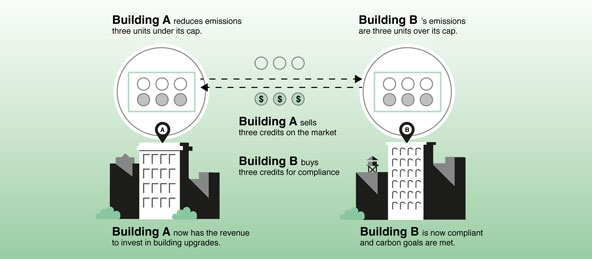
Cap-and-trade systems are currently used in the European Union and several US states, including California and New York.
Another type of carbon market is the carbon tax. In this system, the government sets a price on each ton of carbon emissions. Companies and individuals then pay the tax based on their emissions. This creates an economic incentive for companies to reduce their emissions to avoid paying the tax. Carbon taxes are currently in place in several countries, including Sweden, Switzerland, and Canada.
There are also voluntary carbon markets, where individuals and companies can purchase carbon credits to offset their own emissions. These credits are typically generated from projects that reduce or remove emissions, such as renewable energy projects or reforestation efforts. Voluntary carbon markets are not currently regulated by governments, but some companies use them as part of their corporate social responsibility efforts.
The carbon market offers opportunities for investors to create revenue streams. The substantial energy-efficiency retrofits and renewable energy technologies inherent in energy savings performance contract (ESPC) projects typically require a large initial capital investment and may have a relatively long payback period. Debt payments are tied to the energy cost savings guaranteed for the project, so the agency pays for the capital improvements of the ESPC project with the money saved by the project (i.e., the difference between pre-installation and post-installation energy use and other related costs).
Building owners and engineers face several dilemmas when it comes to decarbonization. These include inconsistencies in regulations, the tension between corporate sustainability goals and regulatory requirements, the choice of power generation sources, the high cost of investment, and limited retrofit options.
One dilemma is the inconsistency in regulations across different jurisdictions. Building owners and engineers may face conflicting regulations from different levels of government or agencies, making it difficult to determine which requirements to prioritize. This can lead to confusion and delay in implementing decarbonization measures.
Another issue is the tension between corporate sustainability goals and regulatory requirements. Building owners may face pressure from stakeholders to set ambitious sustainability targets while also complying with existing regulations. This can create a challenge for building owners and engineers, who may need to navigate complex regulatory frameworks while also striving to meet their sustainability goals.
Choosing the power generation source is another dilemma facing building owners and engineers. The source of electricity used in buildings can have a significant impact on their carbon footprint. This choice is made even more difficult as it is not always clear how a utility generates power. Electrical power generated using fossil fuel still leaves a significant carbon footprint.
While renewable energy sources such as wind and solar are becoming increasingly cost-competitive, some building owners may still rely on fossil fuels due to their lower initial costs. This can make it difficult for building owners to make the switch to renewable energy sources.
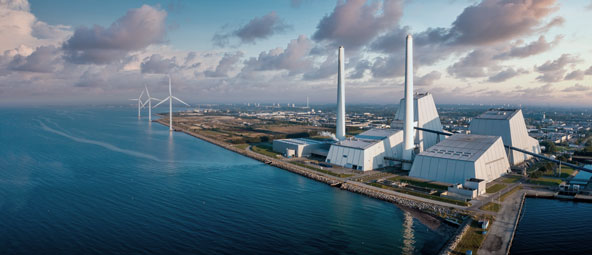
In the world of emissions reduction, the high cost of investment is also a significant issue. Decarbonizing buildings often requires significant investment in energy efficiency upgrades, renewable energy systems, and other decarbonization measures. These investments can provide long-term benefits, such as reduced energy costs and increased asset value, but the high initial costs can be a barrier for building owners.
Finally, limited retrofit options pose a challenge for building owners and engineers. Older buildings may have limited retrofit options due to their design, construction, or historical significance. Retrofitting these buildings may require significant modifications or upgrades that are difficult or expensive to implement. This can limit the options available to building owners and engineers for reducing the carbon footprint of these buildings.
Enervex, a leading provider of energy-efficient ventilation and exhaust systems, has responded to the commercial market's growing concern over the use of natural gas. While there are efforts to eventually phase out the use of natural gas, ENERVEX recognizes that most experts agree that this would likely not happen until 2040 at the earliest. This is because renewable sources of energy are intermittent and unreliable, baseload form of energy like natural gas is needed until other technologies are developed to ensure energy can be supplied whenever needed. Electrical power can and will still be generated by fossil fuel for the foreseeable future.
In multi-story, multi-residential buildings, the demand for energy-efficient and sustainable ventilation systems is vital. One such system is demand-controlled ventilation or exhaust (DCV). The system can assist in providing improved indoor air quality, energy savings, and quieter operation due to reduced air infiltration and exfiltration while reducing Building Energy Load.
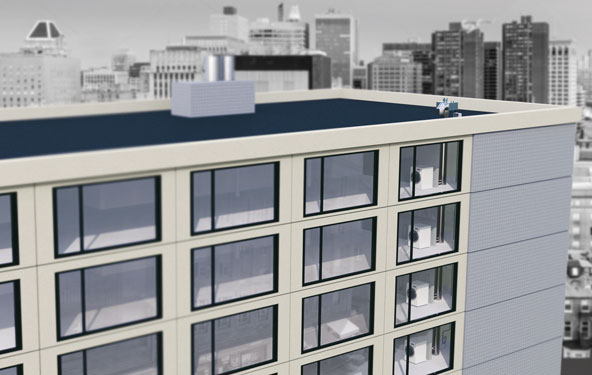
Demand Controlled Ventilation (DCV) is an energy-efficient ventilation strategy that adjusts the ventilation rate based on the actual occupancy and pollutant levels of a building. Instead of providing a constant volume of ventilation air, DCV systems vary the amount of fresh air based on the actual demand for ventilation.
The primary goal of a Demand Controlled Exhaust System is to reduce energy-consumption by adjusting the exhaust rate to the actual need. This can reduce the amount of energy required for heating and cooling, as well as the energy used to condition and distribute fresh air.
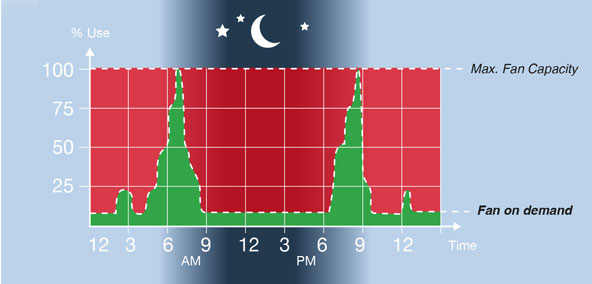
To help building owners and engineers reduce energy consumption in multi-story buildings, apartments, condos, schools, hospitals, hotels and resorts – ENERVEX offers MBESx, Modulating Building Exhaust Systems as energy-efficient ventilation and exhaust solutions for clothes dryers, bathrooms and kitchens.
ENERVEX recognizes the challenges facing the residential, institutional, and commercial markets as they seek to reduce energy consumption and move toward renewable energy sources. While recognizing the need for natural gas as a reliable form of energy, ENERVEX also encourages building owners and engineers to consider innovative solutions such as demand controlled exhaust.
In recent years, there has been increased interest in quantifying the energy savings associated with demand-controlled ventilation and exhaust systems. One area of interest has been in local exhaust applications for clothes dryers, kitchens and bathrooms. However, quantifying the energy savings associated with DCV systems in these applications can be challenging. One reason for this is that it can be difficult to accurately predict how often and when the exhaust system will be needed.
A project by the Natural Gas Technologies Centre in Montreal examined the cost-effectiveness of switching from electric to natural gas-fired dryers in multi-residential buildings' laundry facilities. The study found that dryers located in laundry rooms operated for an average of 185 minutes per day, and that a demand control ventilation system (MDVS control system) could significantly reduce dryers' energy consumption by 3% while preventing up to 10 times more conditioned air from being exhausted.
DCV is particularly applicable to vertical subdivisions, making it an ideal solution for multi-family buildings. By utilizing DCV, building owners and operators can achieve significant energy savings from reduced volumes of conditioned air exhausted and lower fan operating costs.
For instance, a fixed-speed ventilation system with exhaust system for clothes dryers can exhaust close to $800 of conditioned air annually per dryer, while a DCV system only exhausts $250. This offers significant cost and energy savings. Similar savings can also be found for bathroom and kitchen exhaust systems.
Installing a Demand Controlled Ventilation (DCV) system in a condominium building in Maryland in 2008 resulted in estimated annual savings of $42,644, with a payback period of 22 months and a 5-year ROI of 172%. The total project cost for installing DCV systems in all 14 shafts was around $71,000, with the installation cost being approximately $16,000. The DCV system reduced the amount of conditioned air exhausted through the kitchen hoods when not in use, resulting in significant energy savings.
To ensure compliance with these regulations, many building codes and standards require the use of DCV systems as well as FEI-rated fans in multi-story and commercial buildings.
For example, the International Mechanical Code (IMC) requires DCV systems in buildings with high-occupancy spaces, such as classrooms and conference rooms, to maintain proper indoor air quality levels. The ASHRAE Standard 62.1 also provides guidelines for ventilation rates and requires the use of DCV systems in certain building types. ASHRAE Standard 90.1 provides fan efficiency guidelines.
Building owners and managers who do not comply with these regulations can face fines, penalties, and legal liability for any harm caused to occupants because of poor indoor air quality. Therefore, installing DCV systems can not only improve indoor air quality and occupant comfort but also ensure compliance with building codes and standards, reducing the risk of legal and financial consequences.
DCV systems can provide an excellent measurable lifetime return because they tend to save a significant amount of energy and require little maintenance. DCV systems are engineered for heavy-use applications, require less material during construction or renovation, and only require minor maintenance costs such as regular cleaning of ducts and fan interiors.
End-of-life scenarios for DCV systems include reclamation and recycling. All parts and components of fans can be recycled.
Demand Controlled Ventilation systems usually qualify for grants or incentives from local, state, and federal governments due to their potential for energy savings.
Building teams that specify DCV systems may be eligible for points in the Leadership in Energy and Environmental Design (LEED) Building Rating System. DCV systems can earn points in the Energy & Atmosphere category for optimizing energy performance, in the Indoor Environmental Quality category for improving indoor air quality, and in the Innovation & Design Process category for incorporating innovative technologies and strategies.
The availability of grants or incentives from local, state, and federal governments for installing Demand Controlled Ventilation (DCV) systems can benefit building owners by reducing the overall cost of installation and increasing the return on investment.
To design and select the appropriate DCV system, it's important to consider principles and recommended practices that align with the building's specific needs. The process should include saving models to determine potential energy savings and ROI on retrofit projects. It’s equally crucial to consider performance expectations, such as durability, energy efficiency, sustainability, and maintenance requirements.
Other factors affecting the selection of a ventilation system include:
● design and environmental considerations
● installation and renovation logistics
● ongoing productivity and flexibility considerations
● ongoing maintenance
● reclamation and after-use options
To achieve the benefits of DCV systems in multi-story, multi-residential buildings, it's essential to work with reputable ventilation exhaust system providers like ENERVEX with experience in building tailored solutions. By doing so, building owners and operators can create more sustainable and energy-efficient buildings that reduce their carbon footprint and achieve long-term savings on their energy bills.
The MBESx system from ENERVEX comprises an FEI-rated BEFx Exhaust Fan, an MEC 24 Constant Pressure Controller, and an XTP Pressure Transducer. It uses an EC-motor and an MSC EDrive E3 Motor Speed Controller to modulate the fan's speed based on the ventilation demands of the building.
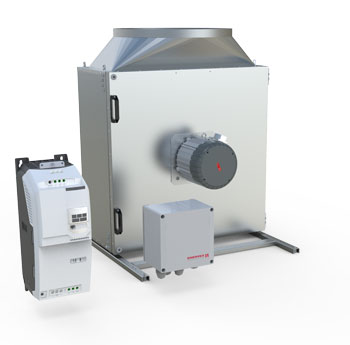
It is highly suitable for retrofitting and can discharge either inline or on the roof, eliminating the need for cleaning hard-to-get-to architectural vents. The system operates quietly, eliminating constant fan noise and noise from speed variations. It can react to changes in pressure caused by appliances and has a ramp-up and ramp-down time of no more than 20 seconds.
To create more sustainable and energy-efficient buildings, consider implementing the MBESx system from ENERVEX, a demand-controlled ventilation (DCV) system that costs less to operate than fixed-speed CAV systems and can save up to 85% of the cost of exhausted conditioned air. Contact ENERVEX today to learn more about their tailored solutions for your building's specific needs.